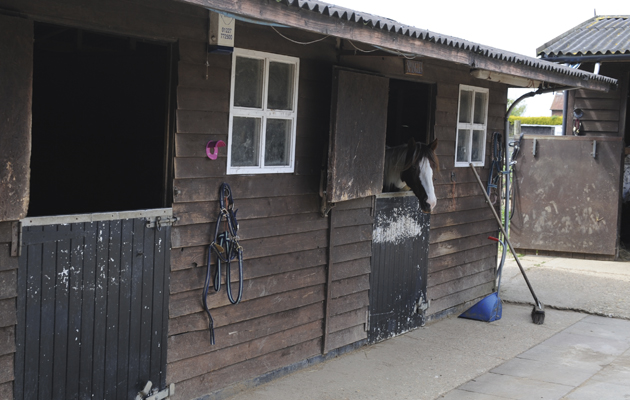A yard owner who has spent years fighting to decrease his business rates hopes the concessions he won could benefit others in a similar position.
Walter Brinzer, of Chelmsford Equestrian Centre in Essex, went to tribunal this autumn as part of his appeal against the values assigned to his premises, from which rates are calculated.
And although the tribunal did not agree with some of his basic arguments — such as the £250 value assigned to each of his stables being too high compared to £165 in areas of London and Surrey — points ceded by the Valuation Office Agency (VOA) beforehand meant he has already been refunded some £6,000.
{"content":"PHA+TXIgQnJpbnplciB0b2xkIDxlbT5IJmFtcDtIPC9lbT4gd2hpbGUgaXQgaXMgc2ltcGxlIHRvIGNhbGN1bGF0ZSB0aGUgcmF0ZWFibGUgdmFsdWUgb2YgYSBzaG9wLCBmb3IgZXhhbXBsZSwgYXMgdGhleSBhcmUgb2Z0ZW4gcmVudGVkIGFuZCB0aGVyZSB3aWxsIGJlIHNpbWlsYXIgbG9jYWwgcHJlbWlzZXMgZm9yIGNvbXBhcmlzb24sIHRoZSBzYW1lIGNhbm5vdCBiZSBzYWlkIGZvciBlcXVlc3RyaWFuIGNlbnRyZXMuPC9wPgo8cD48ZGl2IGNsYXNzPSJhZC1jb250YWluZXIgYWQtY29udGFpbmVyLS1tb2JpbGUiPjxkaXYgaWQ9InBvc3QtaW5saW5lLTIiIGNsYXNzPSJpcGMtYWR2ZXJ0Ij48L2Rpdj48L2Rpdj48c2VjdGlvbiBpZD0iZW1iZWRfY29kZS0zMSIgY2xhc3M9ImhpZGRlbi1tZCBoaWRkZW4tbGcgcy1jb250YWluZXIgc3RpY2t5LWFuY2hvciBoaWRlLXdpZGdldC10aXRsZSB3aWRnZXRfZW1iZWRfY29kZSBwcmVtaXVtX2lubGluZV8yIj48c2VjdGlvbiBjbGFzcz0icy1jb250YWluZXIgbGlzdGluZy0tc2luZ2xlIGxpc3RpbmctLXNpbmdsZS1zaGFyZXRocm91Z2ggaW1hZ2UtYXNwZWN0LWxhbmRzY2FwZSBkZWZhdWx0IHNoYXJldGhyb3VnaC1hZCBzaGFyZXRocm91Z2gtYWQtaGlkZGVuIj4NCiAgPGRpdiBjbGFzcz0icy1jb250YWluZXJfX2lubmVyIj4NCiAgICA8dWw+DQogICAgICA8bGkgaWQ9Im5hdGl2ZS1jb250ZW50LW1vYmlsZSIgY2xhc3M9Imxpc3RpbmctaXRlbSI+DQogICAgICA8L2xpPg0KICAgIDwvdWw+DQogIDwvZGl2Pg0KPC9zZWN0aW9uPjwvc2VjdGlvbj48L3A+CjxwPuKAnFRoZXnigJlyZSBtZWFudCB0byB2YWx1ZSB3aGF0IGEgcHJvcGVydHkgd291bGQgYmUgd29ydGggdG8gcmVudCBvbiB0aGUgb3BlbiBtYXJrZXQs4oCdIGhlIHNhaWQuIOKAnEJ1dCB0aGV5IGhhdmUgdmVyeSBsaXR0bGUgaW5mb3JtYXRpb24gb24gdGhhdCBtYXJrZXQuPC9wPgo8cD7igJxTbyB0aGUgdmFsdWF0aW9uIG9mZmljZXIgd2lsbCBicmVhayBpdCBkb3duIOKAlCBzcXVhcmUgbWV0ZXJhZ2Ugb2Ygc3RhYmxlcywgYXJlbmFzLCBzdG9yYWdlLCBldGMg4oCUIGFuZCBwdXQgYSB2YWx1ZSBvbiBlYWNoIHRvIGNhbGN1bGF0ZSB0aGUgb3ZlcmFsbCB2YWx1ZS7igJ08L3A+CjxwPk1yIEJyaW56ZXIgcmVzZWFyY2hlZCB0aGUgdmFsdWVzIGF0dGFjaGVkIHRvIGZhY2lsaXRpZXMgaW4gaGlzIGFyZWEgYW5kIG90aGVycyBhbmQgZm91bmQgdGhhdCB3aGlsZSBpbiBFc3NleCwgb3V0ZG9vciBhcmVuYXMgd2VyZSB2YWx1ZWQgYXQgwqMyLjUwIHBlciBzcW0sIGluIG1hbnkgb3RoZXIgYXJlYXMsIGl0IHdhcyBvbmx5IMKjMS4gVGhlIFZPQSBhZ3JlZWQgdG8gcmVkdWNlIGhpcyB0byDCozEuNTAgYmVmb3JlIHRoZSB0cmlidW5hbC48L3A+CjxkaXYgY2xhc3M9ImFkLWNvbnRhaW5lciBhZC1jb250YWluZXItLW1vYmlsZSI+PGRpdiBpZD0icG9zdC1pbmxpbmUtMyIgY2xhc3M9ImlwYy1hZHZlcnQiPjwvZGl2PjwvZGl2Pgo8cD5CZWZvcmUgdGhlIGhlYXJpbmcsIE1yIEJyaW56ZXIgYWxzbyBzZWN1cmVkIGEgZGlzY291bnQgZnJvbSDCozE1IHRvIMKjMTAgcGVyIHNxbSBvbiBoaXMgc3RvcmFnZSBzcGFjZSB2YWx1ZS4gQXMgYSBmb3JtZXIgZmFybSwgaGlzIGNlbnRyZSBoYXMgbGFyZ2Ugc3RvcmFnZSBhcmVhcyBidXQgaGUgYXJndWVkIHRoZXNlIGRpZCBub3QgYWRkIHZhbHVlLiBUaGUgVk9BIGFsc28gYWdyZWVkIGhpcyBzbWFsbGVyIHBvbnkgc3RhYmxlcyBzaG91bGQgYmUgcmF0ZWQgYXMgbGVzcyB2YWx1YWJsZSB0aGFuIHN0YW5kYXJkIG9uZXMuPC9wPgo8cD5IZSBzZWN1cmVkIGEgMTAlIGRpc2NvdW50IG9uIHRoZSBvdmVyYWxsIHZhbHVlLCBvd2luZyB0byB0aGUgc2l6ZSBvZiBoaXMgcHJlbWlzZXMsIGFzIGEgbGFyZ2UgeWFyZCBpcyBoYXJkZXIgdG8gcmVudCBvdXQgdGhhbiBhIHNtYWxsZXIuPC9wPgo8ZGl2IGNsYXNzPSJhZC1jb250YWluZXIgYWQtY29udGFpbmVyLS1tb2JpbGUiPjxkaXYgaWQ9InBvc3QtaW5saW5lLTQiIGNsYXNzPSJpcGMtYWR2ZXJ0Ij48L2Rpdj48L2Rpdj4KPHA+TXIgQnJpbnplciBob3BlcyB0aGUgVk9B4oCZcyBjb25jZXNzaW9ucyBtYXkgYmVuZWZpdCBvdGhlcnMgd2hvIGNvdWxkIGFsc28gc2VjdXJlIGRpc2NvdW50cywgYnV0IGJlbGlldmVzIGFwcGVhbGluZyBjYW4gYWxzbyBoYXZlIGEgd2lkZXIgaW1wYWN0LjwvcD4KPHA+4oCcVGhlIFZPQSBoYXMgdG8gcmVseSBvbiBoaXN0b3JpY2FsIGRhdGEgYW5kIGlmIG5vIG9uZSBhcHBlYWxzLCBpdOKAmXMgYXMgaWYgdGhhdCBtdXN0IGJlIHJpZ2h0LOKAnSBoZSBzYWlkLiDigJxUaGUgaWRlYSBpcyB0aGF0IHRoZSByYXRlYWJsZSB2YWx1ZXMgaW4geW91ciBhcmVhIGhhdmUgYmVlbiBhZ3JlZWQgd2l0aCBvdGhlciBwZW9wbGUsIHNvIGV2ZW4gaWYgdGhleeKAmXJlIHdyb25nLCB0aGV54oCZcmUgc2VlbiBhcyByaWdodC48L3A+CjxkaXYgY2xhc3M9ImFkLWNvbnRhaW5lciBhZC1jb250YWluZXItLW1vYmlsZSI+PGRpdiBpZD0icG9zdC1pbmxpbmUtNSIgY2xhc3M9ImlwYy1hZHZlcnQiPjwvZGl2PjwvZGl2Pgo8cD7igJxJIHdhcyB0b2xkIG5vLW9uZSBlbHNlIGluIHRoZSBhcmVhIGhhZCBjaGFsbGVuZ2VkIHRoZSByYXRlYWJsZSB2YWx1ZSBvZiBzdGFibGVzLCBzbyDigJh0aGFua3MgZm9yIGJyaW5naW5nIGl0IHRvIG91ciBhdHRlbnRpb24sIGJ1dOKApuKAmS48L3A+CjxwPuKAnFdlIHRvbGQgdGhlIFZPQSBhbGwgdGhlIGluZm9ybWF0aW9uIHRoZXkgaGFkIHdhcyB3cm9uZywgYnV0IHVubGVzcyBwZW9wbGUgYXBwZWFsLCB3ZeKAmXJlIGZpZ2h0aW5nIGEgYmF0dGxlIHdlIGNhbuKAmXQgd2luLiBPbmNlIHRoZSBsb2NhbCB0b25lIGlzIGVzdGFibGlzaGVkLCBpdOKAmXMgdmVyeSBoYXJkIHRvIGNoYW5nZSBpdC7igJ08L3A+CjxwPk1yIEJyaW56ZXLigJlzIGFwcGVhbCB3YXMgYWdhaW5zdCBoaXMgMjAxMCB2YWx1ZXMuIEhlIG5vdyBwbGFucyB0byBjaGFsbGVuZ2UgdGhlIOKAnG91dHJhZ2VvdXPigJ0gaW5jcmVhc2UgaW4gdmFsdWVzIG9uIHdoaWNoIDxlbT5IJmFtcDtIPC9lbT4gaGFzIHJlcG9ydGVkLCB3aGljaCBjYW1lIGludG8gZWZmZWN0IGluIDIwMTcuPC9wPgo8cD7igJxUaGVyZeKAmXMgdmVyeSBsaXR0bGUgZGF0YSB0byBzdXBwb3J0IHRoaXMs4oCdIGhlIHNhaWQuIOKAnE5vdyBJIG5lZWQgdG8gZ28gYmFjayBmb3IgdGhlIG5leHQgcm91bmQsIGFzIEkgY2Fu4oCZdCBzZWUgaG93IHRoaXMgaXMganVzdGlmaWVkLuKAnTwvcD4KPHA+QSBzcG9rZXNtYW4gZm9yIHRoZSBCcml0aXNoIEhvcnNlIFNvY2lldHkgKEJIUyksIHdoaWNoIGhhcyBiZWVuIGNhbXBhaWduaW5nIGFnYWluc3QgcmF0ZSBsZXZlbHMsIHRvbGQgPGVtPkgmYW1wO0g8L2VtPjog4oCcQSBrZXkgY29uY2VybiBpcyB0aGF0IHJpZGluZyBzY2hvb2xzIGFuZCBsaXZlcnkgeWFyZHMgaGF2ZSBiZWVuIGhpdCBoYXJkIHdpdGggdGhlIHJhdGVhYmxlIHZhbHVlcyB0aGF0IGNhbWUgaW50byBmb3JjZSBpbiAyMDE3LiBUaGUgaW5jcmVhc2UgdGhlc2UgZXF1ZXN0cmlhbiBidXNpbmVzc2VzIGFyZSBiZWluZyBzdWJqZWN0IHRvIGFyZSBjb25zaWRlcmFibHkgbW9yZSB0aGFuIGF2ZXJhZ2UgZm9yIGJ1c2luZXNzZXMgYWNyb3NzIEVuZ2xhbmQgYW5kIFdhbGVzLjwvcD4KPGRpdiBjbGFzcz0iaW5qZWN0aW9uIj48L2Rpdj4KPHA+4oCcV2Ugd291bGQgYWR2aXNlIGFueW9uZSB3aG8gaGFzIGFueSBkb3VidCBhYm91dCB3aGV0aGVyIHRoZWlyIHByZW1pc2VzIGhhcyBiZWVuIGluY29ycmVjdGx5IHZhbHVlZCB0byBjaGVjayB3aXRoIHRoZSBWT0EuIFdhbHRlcuKAmXMgcGVyc2lzdGVuY2UgaGFzIGJlZW4gYmVuZWZpY2lhbCBhcyBpdCBoYXMgcmVzdWx0ZWQgaW4gaGltIHBheWluZyBsZXNzIGJ1c2luZXNzIHJhdGVzLuKAnTwvcD4KPHA+VGhlIFZPQSB0b2xkIDxlbT5IJmFtcDtIPC9lbT4gaXQgd2FzIHVuYWJsZSB0byBjb21tZW50LCBvd2luZyB0byB0aGUgZm9ydGhjb21pbmcgZ2VuZXJhbCBlbGVjdGlvbi48L3A+CjxwPkJ1c2luZXNzZXMgY2FuIHNlZSBob3cgdmFsdWVzIHdlcmUgY2FsY3VsYXRlZCwgYW5kIOKAnHByb3Bvc2UgY2hhbmdl4oCdIGF0IDxhIGhyZWY9Imh0dHA6Ly93d3cudm9hLmdvdi51ay92YWx1YXRpb24iIHRhcmdldD0iX2JsYW5rIiByZWw9Im5vZm9sbG93IG5vb3BlbmVyIj52b2EuZ292LnVrL3ZhbHVhdGlvbjwvYT4uPC9wPgo8cD4K"}
You may also be interested in…
Credit: Steve Bardens
Some equestrian businesses face huge increases in their business rates — H&H looks at what you need to know and
A dressage rider plans to appeal after being told she must pay almost £2,000 in rates on her manège
Horse owners forced to fight their cases over non-domestic rate claims by local councils
Credit: Time Inc UK
It is crucial as many centres as possible contribute to providing evidence to chancellor Philip Hammond
Credit: Lucy Merrell
The owner has warned other yards may be forced to close due to the tax rise, damaging the future of
Stay in touch with all the news in the run-up to and throughout the major shows and events during 2025 and beyond with a Horse & Hound subscription. Subscribe today for all you need to know ahead of these major events, plus online reports on the action as it happens from our expert team of reporters and in-depth analysis in our special commemorative magazines. Have a subscription already? Set up your unlimited website access now
H&H news editor
Eleanor is an experienced journalist who spent over eight years working for local and national newspapers before joining H&H as news editor in March 2016. Passionate about equine welfare and exposing the truth, Eleanor has reported on all aspects of the industry, from Brexit to anti-bullying campaigns, and from dressage rules to mules. Her sport of choice is showjumping, in which she competes her own horses, and she also enjoys reporting at local jumping shows through to international championships.





